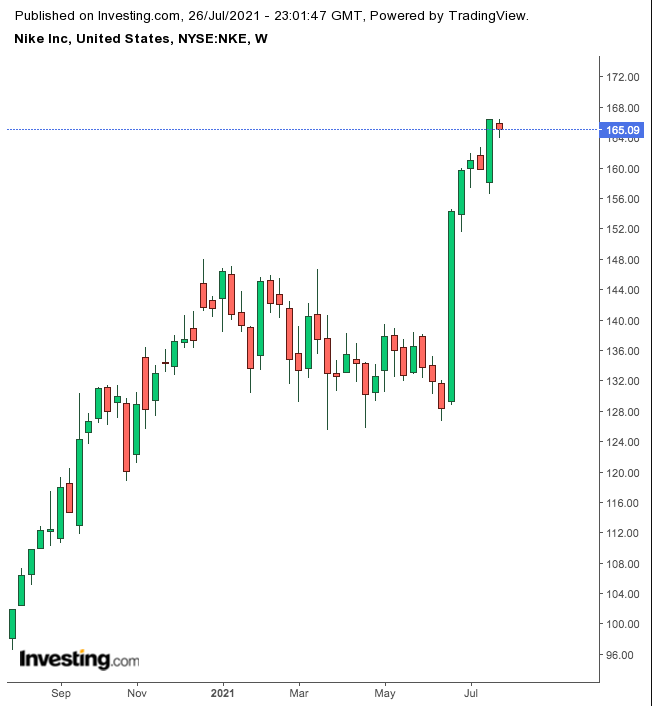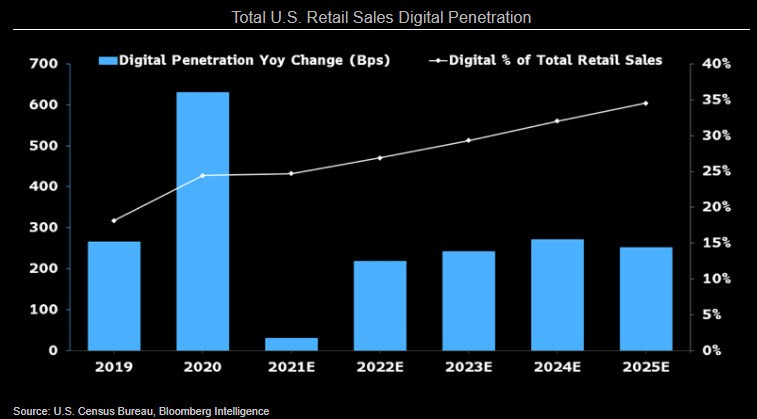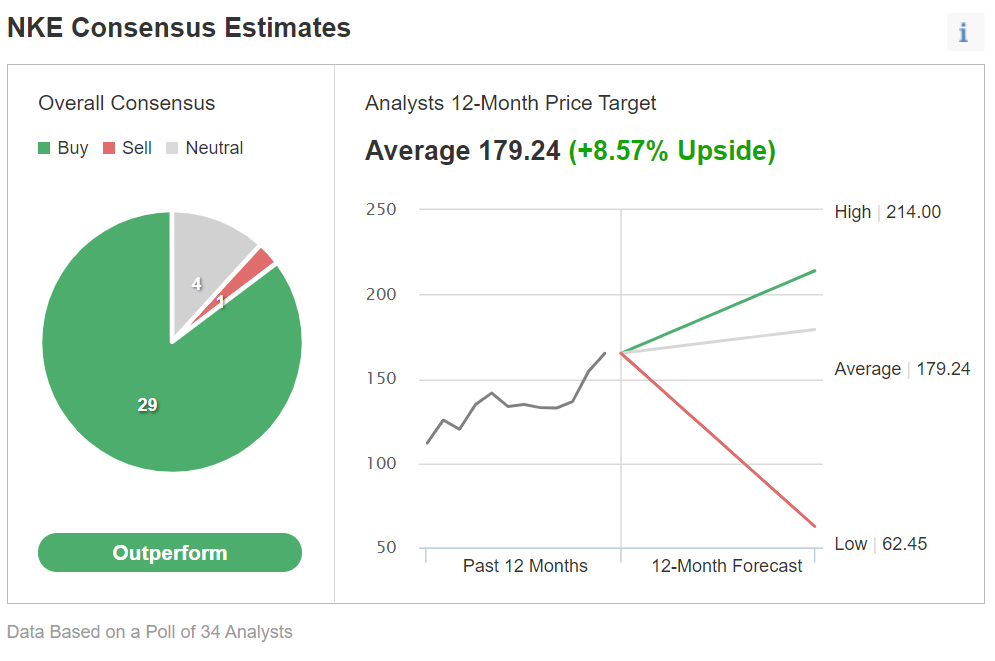Summary:
- Nike sales and margins are expanding, helped by a successful digital transformation
- Shares have jumped 25% in the past 30 days on earnings momentum
- There is more room to the upside as consumer environment remains favorable
During the past few months, sportswear giant Nike (NYSE:NKE) has seen a spectacular rebound in its stock. Shares, powered by surging sales, rose about 25% during that period, on signs that the Beaverton, Oregon-based company is building a new financial model that will continue to fuel sustainable growth over the long run.

Behind this exuberance are the company’s record quarterly sales, which topped $12 billion for the first time in the company’s 50-year history. The sales expansion after the health crisis gave a strong signal to investors that the maker of Air Force 1s as well as Jordan and Converse footwear is entering another hyper-growth cycle, making its shares attractive.
After this powerful move, however, two logical questions being asked by long-term investors are: How far will this rally go? And: Is the stock already in overbought territory?
Before tackling these questions, here's a deeper look at the factors at play right now for NKE.
Pent-Up Demand
During the pandemic, which forced people to remain indoors and prompted the cancellation of sporting events, Nike sales suffered. They dropped about 40% in the quarter that ended in May 2020, from their pre-pandemic level of more than $10 billion.
But as the U.S. economy began to reopen this spring, sales came back quickly, fuelled by pent-up demand and the massive buying power that consumers acquired through decreased spending and saving during the pandemic.
Global sales almost doubled in the period that ended May 31, powered by a more than 70% surge in direct-to-consumer shipments. Nike also fared better in China than some investors had feared amid calls in the country to boycott global brands for their comments on alleged human rights abuses in Xinjiang.
Sales in the Greater China region rose 17% to $1.9 billion in the latest quarter. The company is forecasting low double-digit sales growth in the current year, ending next May. Executives expect growth will be faster in the first half as consumer interest revives.
Said CEO John Donahoe:
“Nike’s strong results this quarter and full fiscal year demonstrate Nike’s unique competitive advantage and deep connection with consumers all over the world."
Digital Transformation
Beyond the short-term nature of the business revival in the post-pandemic environment, there are other catalysts boosting bullish sentiment on Nike’s future growth. The global health crisis has accelerated Nike’s shift to e-tail, creating a direct-to-consumer business that's not just efficient but also responsible for improving its margins.
For several quarters, Nike’s online sales have surged more than 80% and exceeded the company’s target for revenue from this segment to make up 30% of total sales. But this windfall didn't happen just because of sheer luck. Right before the pandemic hit, Nike handed the reins to Donahoe, who had been formerly the top executive at eBay (NASDAQ:EBAY).
Donahoe, who took over as CEO on Jan. 13, 2020, was quick to build on Nike’s online momentum through its own website and stores. He reduced the number of wholesale outlets that could sell the company's goods, following its exit from Amazon's (NASDAQ:AMZN) platform in 2019. In addition, Nike invested heavily to improve the digital experience for customers by improving its apps and guided workouts.
In the early months of the pandemic, Nike closed stores but continued to pay its workers. At the same time it accelerated its digital push to entice consumers stuck in their homes.
The COVID-19 pandemic has changed the U.S. retail landscape by accelerating e-commerce adoption among shoppers, according to analysis by Bloomberg, which sees online shopping ramping up to represent 35% of the total retail sales by 2025, from 14% in 2019.

Source: Bloomberg
In its latest forecast, Nike expects its online sales to make up about 60% of total sales in 2025, up from about 40%.
Analysts Remain Bullish
Due to these projections and a considerable improvement in Nike’s margins as it moves its sales to a low-cost online model, analysts are bullish on the footwear and sports apparel heavyweight's shares, even after the powerful rally this year.

Chart: Investing.com
According to Investing.com, of 34 Wall Street analysts polled, 29 assigned an “outperform” rating to the stock, forcasting the price will surge an additional 8% from its current level in the next 12 months. Oppenheimer analysts last week raised their price target on the athletic equipment and apparel retailer to $195 from $150, and said the stock has more room to run.
“On the heels of much better than expected Q4 (May) results and with shares through our prior objective, we reviewed carefully NKE and our stance on the story. Conclusion: We believe NKE enjoys further room to run. In our view, recent investments are only beginning to pay off and the market is underappreciating the meaningfully enhanced intermediate-to longer-term EPS power of a digitally-driven NKE model.”
Nike executives told investors last month they expect revenue to increase more than 10% and surpass $50 billion in the fiscal year that began in June, after rising 19% in the just-ended fiscal year. They also expect profit margins to expand as the company sells more items directly to consumers.
Jefferies analyst Randal Konik, who last month correctly predicted that Nike stock had more upside, wrote in his research note:
“Nike is one of the best brands on the planet, the global consumer is very strong, the company is furthering its connection with its consumer through tech, and the company’s distribution model is moving away from wholesale.”
For investors who look to technical signals to help make short-term investment decisions, the most popular indicators—moving averages, oscillators and pivots—are offering a strong buy signal as well.
Income Appeal
With the potential for additional capital gains, Nike is also a staple stock for long-term fixed-income investors. The stock currently pays $0.275 per share on a quarterly basis, which translates to an annual dividend yield of 1%.
That yield obviously doesn’t look attractive when compared to higher-yielding stocks in the market. But analyzing stocks just based on their yields isn’t a good approach. The best dividend stocks are the ones whose payouts are raised regularly.
On this metric, Nike has done a great job. It has hiked its payout for 19 consecutive years, meaning the company has the financial power to successfully ride through downturns and recessions like the one seen during the pandemic that forced many other consumer cyclicals to suspend their payouts.
Its average dividend-growth over the past five years has been more than 10%. With a low payout ratio of just under 30%, along with the current earnings momentum, the consumer giant clearly has much more capacity to hike its dividend.
Bottom Line
Nike continues to remain a top consumer stock to buy even after its powerful run during the past two months. Our bullish case on Nike is supported by its digital transformation, pent-up consumer demand and its strong income appeal for long-term investors.
